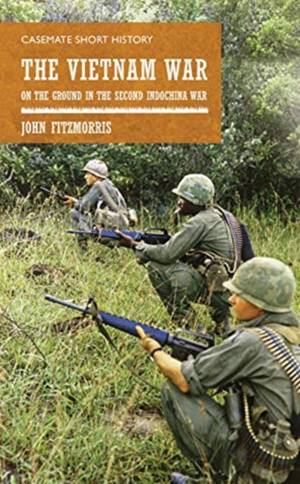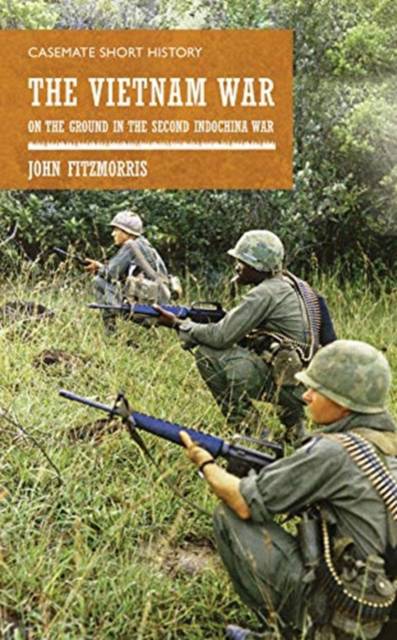
- Retrait gratuit dans votre magasin Club
- 7.000.000 titres dans notre catalogue
- Payer en toute sécurité
- Toujours un magasin près de chez vous
- Retrait gratuit dans votre magasin Club
- 7.000.0000 titres dans notre catalogue
- Payer en toute sécurité
- Toujours un magasin près de chez vous
Description
From its origins as a postcolonial era conflict in the 1940s, the Vietnam War (1955-1975) became an epoch-defining event. The origins of the war go all the way back to World War II, when the political leader Ho Chi Minh formed the Viet Minh, or the League for the Independence of Vietnam, to fight both the Japanese invaders and the French colonial rulers. After the war the struggle for independence continued. America, after initially supporting Ho Chi Minh, hardened its stance with the Cold War intensifying, and in 1955 President Eisenhower pledged his firm support to western-leaning South Vietnam.
During the 1950s America first provided military advice and equipment with only a few hundred troops on the ground. That steadily increased in the 1960s and in 1965-66 200,000 US troops were sent. The North Vietnamese army supported by the Soviet Union, China, and other communist Allies and the South Vietnamese army supported primarily by the United States, used vastly differing tactics. The communists fought a guerrilla war, ambushing US patrols, setting booby traps and landmines, and planting bombs in towns. They mingled in with local civilians making identification of the enemy fraught with difficulty. The Americans by contrast fought a high-tech war, using B52 bombers, artillery, helicopters, napalm, and defoliants to support ground operations. It was a bloody and bitter war that spilled into neighboring countries; with a constant stream of horrific footage beaming into their living rooms, public opinion in America turned against the war, precipitating mass public protest, and ultimately bringing what became thought of as an 'unwinnable' war to an end in 1975.
This concise history gives a complete overview of the war, from its origins to its conclusion. It covers the main sequence of events, including battles such as the Tet Offensive and the My Lai massacre, and how the war gained such a foothold in popular culture, one that still resonates today. It also looks at what it was like to fight for the ordinary 'grunt' soldiers, pitched into a complex, high-risk conflict in an alien environment.
During the 1950s America first provided military advice and equipment with only a few hundred troops on the ground. That steadily increased in the 1960s and in 1965-66 200,000 US troops were sent. The North Vietnamese army supported by the Soviet Union, China, and other communist Allies and the South Vietnamese army supported primarily by the United States, used vastly differing tactics. The communists fought a guerrilla war, ambushing US patrols, setting booby traps and landmines, and planting bombs in towns. They mingled in with local civilians making identification of the enemy fraught with difficulty. The Americans by contrast fought a high-tech war, using B52 bombers, artillery, helicopters, napalm, and defoliants to support ground operations. It was a bloody and bitter war that spilled into neighboring countries; with a constant stream of horrific footage beaming into their living rooms, public opinion in America turned against the war, precipitating mass public protest, and ultimately bringing what became thought of as an 'unwinnable' war to an end in 1975.
This concise history gives a complete overview of the war, from its origins to its conclusion. It covers the main sequence of events, including battles such as the Tet Offensive and the My Lai massacre, and how the war gained such a foothold in popular culture, one that still resonates today. It also looks at what it was like to fight for the ordinary 'grunt' soldiers, pitched into a complex, high-risk conflict in an alien environment.
Spécifications
Parties prenantes
- Auteur(s) :
- Editeur:
Contenu
- Nombre de pages :
- 160
- Langue:
- Anglais
- Collection :
Caractéristiques
- EAN:
- 9781612006796
- Date de parution :
- 01-04-24
- Format:
- Livre broché
- Format numérique:
- Trade paperback (VS)
- Dimensions :
- 150 mm x 198 mm

Les avis
Nous publions uniquement les avis qui respectent les conditions requises. Consultez nos conditions pour les avis.






